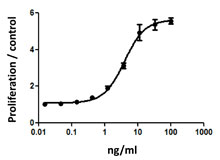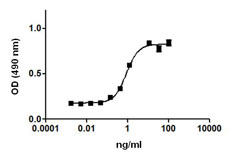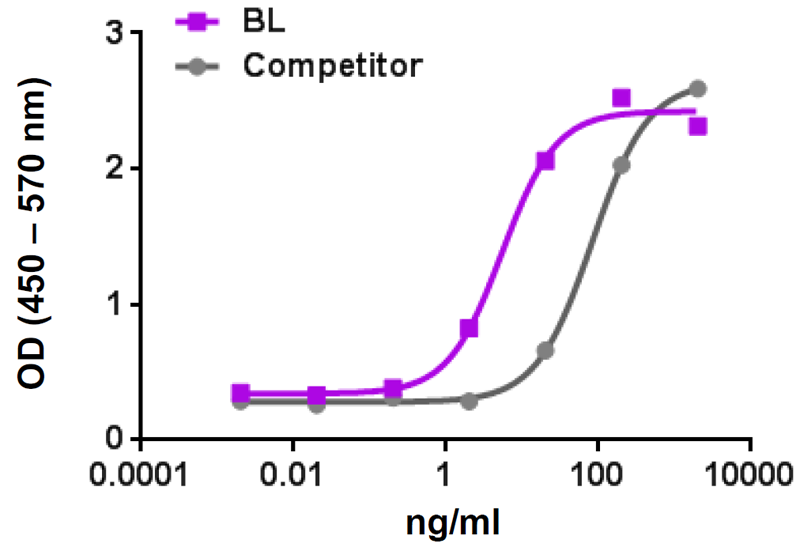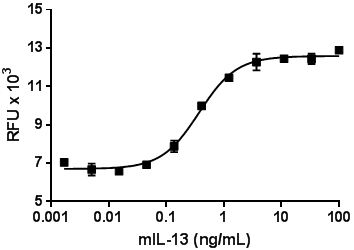- Regulatory Status
- RUO
- Other Names
- Granulocyte/macrophage-colony stimulating factor, CSF-α, Pluripoietin-α, Eosinophil colony stimulating factor (Eo-CSF), Burst promoting activity (BPA)
- Ave. Rating
- Submit a Review
- Product Citations
- publications
| Cat # | Size | Price | Quantity Check Availability | Save | ||
|---|---|---|---|---|---|---|
| 713704 | 20 µg | 253 CHF | ||||
GM-CSF plays a key role in signaling emergency hematopoiesis (predominantly myelopoiesis) in response to infection. This includes the development of granulocytes and macrophages in the bone marrow and their maintenance, survival, and functional activation at sites of injury or insult. The receptor for GM-CSF is a heterodimer that comprises a major binding subunit (GMRα) and a major signaling subunit (βc). The receptor subunits are always coexpressed on the surface of leukocytes, with βc being expressed at lower levels than GMRα. Certain nonhematopoietic cell types have also been reported to express the GM-CSF receptor and to respond to GM-CSF stimulation in vitro, although the in vivo significance of these observations remains uncertain.
Product DetailsProduct Details
- Source
- Mouse GM-CSF, amino acids Ala18-Lys141 (Accession# NM_009969), was expressed in E. coli.
- Molecular Mass
- The 125 amino acid N-terminal methionylated recombinant protein has a predicted molecular mass of 14.2 kD. The predicted N-terminal amino acid is Met.
- Purity
- >98%, as determined by Coomassie stained SDS-PAGE and HPLC analysis.
- Formulation
- Lyophilized, carrier-free.
- Endotoxin Level
- Less than 0.1 ng per µg of protein.
- Storage & Handling
- Unopened vial can be stored at -20°C or -70°C. For maximum results, quick spin vial prior to opening. Reconstitute in water to a concentration of 0.1-1.0 mg/ml. Do not vortex. It is recommended to further dilute in a buffer, such as 5% Trehalose, and store working aliquots at -20°C to -80°C. Avoid repeated freeze/thaw cycles.
- Activity
- ED50 ≤ 0.05 ng/ml, corresponding to a specific activity of ≥ 2.0 x 107 units/mg as determined by the dose-dependent stimulation of the proliferation of murine FDC-P1 cells.
- Application
-
Bioassay
- Product Citations
-
Antigen Details
- Structure
- Cytokine
- Distribution
- T cells, monocytes, macrophages, fibroblasts, endothelial cells, mast cells.
- Function
- Synergistic with IL-1, IL-3, G-CSF; E21R competitive antagonist for receptor binding; stored in the extracellular matrix with heparan sulfate proteoglycans.
- Interaction
- Granulocyte/macrophage/erythroid/megakaryocytic progenitors, myeloblasts, monoblasts.
- Ligand/Receptor
- Heterodimer GM-CSFR α subunit (CDw116); β-subunit (CDw131) in common.
- Bioactivity
- Granulocyte-macrophage colony-stimulating factor (GM-CSF) and the related cytokines IL-3 and IL-5 regulate the production and functional activation of hematopoietic cells, with GM-CSF acting on monocytes, macrophages and all granulocytes.
- Cell Type
- Hematopoietic stem and progenitors, Embryonic Stem Cells
- Biology Area
- Cell Biology, Stem Cells
- Molecular Family
- Growth Factors, Cytokines/Chemokines
- Antigen References
-
1. Fitzgerald K, et al. Eds. 2001. The Cytokine FactsBook. Academic Press San Diego.
2. Demetri G, et al. 1991. Blood 78:2791.
3. Fan D, et al. 1991. In vivo 5:571.
4. Negrin R, et al. 1992. Adv. Pharmacol. 23:263. - Gene ID
- 12981 View all products for this Gene ID
- UniProt
- View information about GM-CSF on UniProt.org
Related FAQs
- Why choose BioLegend recombinant proteins?
-
• Each lot of product is quality-tested for bioactivity as indicated on the data sheet.
• Greater than 95% Purity or higher, tested on every lot of product.
• 100% Satisfaction Guarantee for quality performance, stability, and consistency.
• Ready-to-use liquid format saves time and reduces challenges associated with reconstitution.
• Bulk and customization available. Contact us.
• Learn more about our Recombinant Proteins. - How does the activity of your recombinant proteins compare to competitors?
-
We quality control each and every lot of recombinant protein. Not only do we check its bioactivity, but we also compare it against other commercially available recombinant proteins. We make sure each recombinant protein’s activity is at least as good as or better than the competition’s. In order to provide you with the best possible product, we ensure that our testing process is rigorous and thorough. If you’re curious and eager to make the switch to BioLegend recombinants, contact your sales representative today!
- What is the specific activity or ED50 of my recombinant protein?
-
The specific activity range of the protein is indicated on the product datasheets. Because the exact activity values on a per unit basis can largely fluctuate depending on a number of factors, including the nature of the assay, cell density, age of cells/passage number, culture media used, and end user technique, the specific activity is best defined as a range and we guarantee the specific activity of all our lots will be within the range indicated on the datasheet. Please note this only applies to recombinants labeled for use in bioassays. ELISA standard recombinant proteins are not recommended for bioassay usage as they are not tested for these applications.
- Have your recombinants been tested for stability?
-
Our testing shows that the recombinant proteins are able to withstand room temperature for a week without losing activity. In addition the recombinant proteins were also found to withstand four cycles of freeze and thaw without losing activity.
- Does specific activity of a recombinant protein vary between lots?
-
Specific activity will vary for each lot and for the type of experiment that is done to validate it, but all passed lots will have activity within the established ED50 range for the product and we guarantee that our products will have lot-to-lot consistency. Please conduct an experiment-specific validation to find the optimal ED50 for your system.
- How do you convert activity as an ED50 in ng/ml to a specific activity in Units/mg?
-
Use formula Specific activity (Units/mg) = 10^6/ ED50 (ng/mL)
 Login / Register
Login / Register 












Follow Us